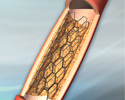Peripheral artery disease - legs
Peripheral vascular disease; PVD; PAD; Arteriosclerosis obliterans; Blockage of leg arteries; Claudication; Intermittent claudication; Vaso-occlusive disease of the legs; Arterial insufficiency of the legs; Recurrent leg pain and cramping; Calf pain with exercisePeripheral artery disease (PAD) is a condition of the blood vessels that supply the legs and feet. It occurs due to narrowing of the arteries in the legs. This causes decreased blood flow, which can injure nerves and other tissues.
The Basics
- Angioplasty and stent placement - peripheral arteries
- Peripheral artery bypass - leg
- Angioplasty and stent placement - peripheral arteries - discharge
- Peripheral artery bypass - leg - discharge
- Transient ischemic attack
- Stroke
- Understanding cardiovascular disease
- Aging changes in the heart and blood vessels
- Arterial embolism
- Heart and vascular services
Tests for Peripheral artery disease - legs
A Closer Look
- Atherosclerosis (Alternative Medicine)
- Peripheral artery disease and intermittent claudication - InDepth (Detailed Report)
- Myocardial infarction (Alternative Medicine)
- Coronary artery disease - InDepth (Detailed Report)
- Heart attack and acute coronary syndrome - InDepth (Detailed Report)
- Stroke - InDepth (Detailed Report)
- Cholesterol - InDepth (Detailed Report)
- Diabetes - type 2 - InDepth (Detailed Report)
- Chronic obstructive pulmonary disease - InDepth (Detailed Report)
- Diabetes - type 1 - InDepth (Detailed Report)
Peripheral artery disease - legs
Peripheral vascular disease; PVD; PAD; Arteriosclerosis obliterans; Blockage of leg arteries; Claudication; Intermittent claudication; Vaso-occlusive disease of the legs; Arterial insufficiency of the legs; Recurrent leg pain and cramping; Calf pain with exercisePeripheral artery disease (PAD) is a condition of the blood vessels that supply the legs and feet. It occurs due to narrowing of the arteries in the legs. This causes decreased blood flow, which can injure nerves and other tissues.
The Basics
- Angioplasty and stent placement - peripheral arteries
- Peripheral artery bypass - leg
- Angioplasty and stent placement - peripheral arteries - discharge
- Peripheral artery bypass - leg - discharge
- Transient ischemic attack
- Stroke
- Understanding cardiovascular disease
- Aging changes in the heart and blood vessels
- Arterial embolism
- Heart and vascular services
Tests for Peripheral artery disease - legs
A Closer Look
- Atherosclerosis (Alternative Medicine)
- Peripheral artery disease and intermittent claudication - InDepth (Detailed Report)
- Myocardial infarction (Alternative Medicine)
- Coronary artery disease - InDepth (Detailed Report)
- Heart attack and acute coronary syndrome - InDepth (Detailed Report)
- Stroke - InDepth (Detailed Report)
- Cholesterol - InDepth (Detailed Report)
- Diabetes - type 2 - InDepth (Detailed Report)
- Chronic obstructive pulmonary disease - InDepth (Detailed Report)
- Diabetes - type 1 - InDepth (Detailed Report)
Peripheral artery disease - legs
Peripheral vascular disease; PVD; PAD; Arteriosclerosis obliterans; Blockage of leg arteries; Claudication; Intermittent claudication; Vaso-occlusive disease of the legs; Arterial insufficiency of the legs; Recurrent leg pain and cramping; Calf pain with exercisePeripheral artery disease (PAD) is a condition of the blood vessels that supply the legs and feet. It occurs due to narrowing of the arteries in the legs. This causes decreased blood flow, which can injure nerves and other tissues.
The Basics
- Angioplasty and stent placement - peripheral arteries
- Peripheral artery bypass - leg
- Angioplasty and stent placement - peripheral arteries - discharge
- Peripheral artery bypass - leg - discharge
- Transient ischemic attack
- Stroke
- Understanding cardiovascular disease
- Aging changes in the heart and blood vessels
- Arterial embolism
- Heart and vascular services
Tests for Peripheral artery disease - legs
A Closer Look
- Atherosclerosis (Alternative Medicine)
- Peripheral artery disease and intermittent claudication - InDepth (Detailed Report)
- Myocardial infarction (Alternative Medicine)
- Coronary artery disease - InDepth (Detailed Report)
- Heart attack and acute coronary syndrome - InDepth (Detailed Report)
- Stroke - InDepth (Detailed Report)
- Cholesterol - InDepth (Detailed Report)
- Diabetes - type 2 - InDepth (Detailed Report)
- Chronic obstructive pulmonary disease - InDepth (Detailed Report)
- Diabetes - type 1 - InDepth (Detailed Report)
Review Date: 5/10/2022
Reviewed By: Deepak Sudheendra, MD, MHCI, RPVI, FSIR, Founder and CEO, 360 Vascular Institute, with an expertise in Vascular Interventional Radiology & Surgical Critical Care, Columbus, OH. Review provided by VeriMed Healthcare Network. Also reviewed by David C. Dugdale, MD, Medical Director, Brenda Conaway, Editorial Director, and the A.D.A.M. Editorial team.

